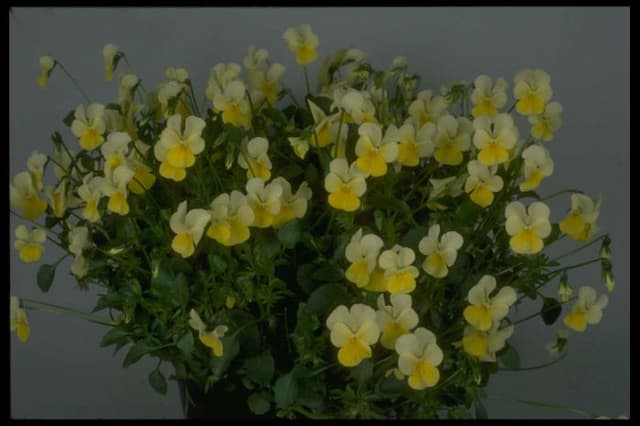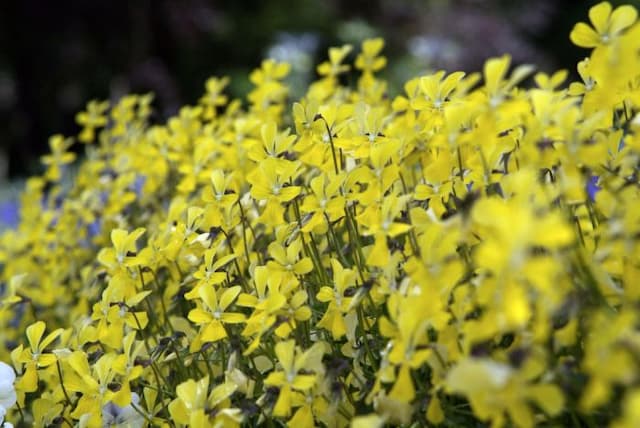Common Dog Violet Viola riviniana

ABOUT
Viola riviniana, commonly known as the Common Dog Violet, is a flowering plant that features a basal rosette of leaves from which its flowers emerge. The leaves are heart-shaped at the base and generally oval, often with serrated edges, and come to a point at the tip. They are medium green in color and have a somewhat glossy finish with a slightly leathery texture. The flowers of the Common Dog Violet typically appear in the Spring and are violet or blue-violet with five petals. The petals are arranged with four facing upwards and one larger petal facing down, which often showcases darker lines or veins that serve as nectar guides for pollinating insects. The lower petal may also have a slight spur. These flowers are unscented, drawing in pollinators primarily through their visual appeal rather than fragrance. As a woodland plant, the Common Dog Violet often grows in clusters, with the flowers rising above the rosette of leaves on slender, upright stalks. The plant's overall form is modest and unassuming, yet it adds a touch of delicate color to the forest floor or garden settings where it is often found.
About this plant
 Names
NamesFamily
Violaceae.
Synonyms
Common Dog Violet, Dog Violet, Wood Violet, Rivin's Violet.
Common names
Viola sylvestris, Viola lactea, Viola arenaria, Viola riviniana var. nemoralis, Viola riviniana subsp. nemoralis, Viola riviniana var. sylvestris.
 Toxicity
ToxicityTo humans
The common dog violet (Viola riviniana) does not contain significant levels of toxic substances that are harmful to humans. Therefore, ingesting this plant typically does not result in poisoning or severe side effects. However, as with any plant, individual allergies or sensitivities are possible, and consumption of the plant, particularly in large quantities, is not advised without appropriate identification and knowledge of the plant's edibility and medicinal properties.
To pets
The common dog violet (Viola riviniana) is not known to be toxic to pets. It lacks harmful substances that would cause poisoning if ingested by animals such as cats and dogs. As with their human counterparts, some pets may have individual allergies or sensitivities to plants, so it's wise to monitor your pet for any unusual reactions after ingestion and consult a veterinarian if any health concerns arise. However, the common dog violet is generally considered safe for pets.
 Characteristics
CharacteristicsLife cycle
Perennials
Foliage type
Deciduous
Color of leaves
Green
Flower color
Blue
Height
4 inches (10 cm)
Spread
6 inches (15 cm)
Plant type
Herb
Hardiness zones
4
Native area
Europe
Benefits
 General Benefits
General Benefits- Attractive to Pollinators: Viola riviniana, commonly known as the Common Dog Violet, is known for its flowers that attract a variety of pollinators, including bees and butterflies, which are essential for the pollination of many other plants.
- Habitat for Insects: Its foliage provides a habitat for caterpillars of some butterfly species, offering a food source and breeding ground.
- Erosion Control: The plant can help stabilize soil in gardens and wild areas, thus preventing erosion through its root system.
- Low Maintenance: The Common Dog Violet is generally easy to grow and doesn't require much care, which can be beneficial for gardeners looking for low-maintenance plants.
- Aesthetic Appeal: With its delicate flowers and attractive foliage, Viola riviniana adds beauty and color to woodland gardens, naturalized areas, or shaded spots in the landscape.
- Wildlife Food Source: The seeds of the Common Dog Violet are a food source for some bird species, integrating well into a wildlife-friendly garden.
- Ground Cover: It can be used effectively as ground cover in suitable environments, covering bare spots and contributing to a layered garden design.
 Medical Properties
Medical Properties- Anti-inflammatory: Viola riviniana, commonly known as Common Dog Violet, has been used traditionally to reduce inflammation.
- Diuretic: There is some evidence that the plant may have diuretic properties, promoting the increase of urine production.
- Laxative: The plant is thought to have been used as a mild laxative in traditional remedies.
- Expectorant: Common Dog Violet may have been used to loosen phlegm and relieve chest congestion.
- Demulcent: The mucilage present in the plant makes it useful as a soothing agent for irritated tissues.
 Air-purifying Qualities
Air-purifying QualitiesThis plant is not specifically known for air purifying qualities.
 Other Uses
Other Uses- As a natural dye: The flowers of the common dog violet can be used to create a natural dye for fabrics or inks, providing a range of colors from green to blue depending on the mordant.
- In perfumery: Although not a common source, the scent of common dog violet flowers has historically been used in creating perfumes and scented oils.
- Culinary decoration: The flowers are edible and can be crystallized or used fresh to decorate desserts and add a subtle flavor.
- Floral arrangements: The common dog violet, with its attractive flowers, can be used in small floral arrangements or posies.
- Ink preparation: Historically, the juice from the flowers of the common dog violet was used as a litmus to test for vinegar acidity.
- As a symbol: The common dog violet often symbolizes modesty and faithfulness, and as such, is used in literature and art to convey these sentiments.
- Crafts: Pressed common dog violet flowers can be used in craft projects, including handmade paper, bookmarks, and cards.
- Garden ground cover: The plant can serve as an effective ground cover in shaded garden areas, providing green foliage and seasonal flowers.
- Eco-friendly confetti: Dried petals of the common dog violet can make a biodegradable confetti alternative for events.
- Education and science: The common dog violet can be used to study the evolution of flower symmetry and pollinator interactions in educational settings.
Interesting Facts
 Feng Shui
Feng ShuiThe Common Dog Violet is not used in Feng Shui practice.
 Zodiac Sign Compitability
Zodiac Sign CompitabilityThe Common Dog Violet is not used in astrology practice.
 Plant Symbolism
Plant Symbolism- Innocence: Common dog-violet (Viola riviniana) often symbolizes innocence due to its delicate and unassuming appearance.
- Modesty: The way the flower tends to hide amongst foliage reflects modesty, suggesting a humble quality.
- Humble Love: In Victorian symbolism, the violet was associated with understated affection, hence representing quiet, faithful love.
- Spiritual Wisdom: The flower is sometimes connected to spiritual insight and the internal rather than the external.
- Survival and Resilience: Common dog-violet is a hardy plant often found in challenging environments, symbolizing the ability to endure and prosper.
 Water
WaterCommon Dog Violet should be watered regularly, ensuring that the soil remains consistently moist but not waterlogged. During the active growing season in spring and summer, it may require watering once every week with about 1 gallon per square yard, depending on the climate and soil conditions. In the cooler months, watering can be reduced. The amount should be adjusted if rainfall supplements the plant's water needs. It's important to avoid overhead watering to prevent leaf diseases, so water at the base of the plant instead.
 Light
LightCommon Dog Violet thrives best in partial shade to full shade conditions. It should be placed in an area where it can receive filtered sunlight or only a few hours of direct morning sun. Too much direct sunlight can cause the leaves to scorch, while too little can lead to leggy growth.
 Temperature
TemperatureCommon Dog Violet prefers moderate temperatures and can generally survive in USDA zones 4 through 8, withstanding temperatures as low as 25°F and as high as 80°F. The ideal temperature range for this plant tends to be between 60°F and 70°F, which promotes healthy growth and flowering.
 Pruning
PruningCommon Dog Violet does not require regular pruning, but deadheading spent flowers can encourage further blooming. Additionally, any dead or damaged leaves should be removed to maintain plant health and appearance. The best time for pruning is after the main flowering period has finished, usually in late spring or early summer.
 Cleaning
CleaningAs needed
 Soil
SoilCommon Dog Violet thrives best in a soil mix that's rich in organic matter, well-draining and moist, with a slightly acidic to neutral pH of 6.0 to 7.0. A combination of garden soil, compost, and perlite or sand would provide the appropriate texture and fertility for healthy growth.
 Repotting
RepottingCommon Dog Violet, being a hardy perennial, doesn't need frequent repotting. It should be repotted or divided every few years as it outgrows its current space or to rejuvenate the soil.
 Humidity & Misting
Humidity & MistingCommon Dog Violet prefers high humidity environments, similar to its natural woodland habitat. Aim for a humidity level that mimics these conditions without being overly saturated.
 Suitable locations
Suitable locationsIndoor
Place in well-lit area, avoid direct sunlight, keep soil moist.
Outdoor
Plant in partial shade, ensure rich, well-drained soil.
Hardiness zone
4-9 USDA
 Life cycle
Life cycleCommon dog violet (Viola riviniana) begins its life cycle as a seed, typically germinating in the spring following dispersal. The seedling develops into a rosette of leaves close to the ground, the juvenile stage of the plant. As it matures, it grows the characteristic heart-shaped leaves and begins vegetative propagation through stolons, which allow the plant to spread. The adult plant flowers from April to June, showing pale violet petals with a white throat, which are pollinated by insects, primarily bees. After pollination, the flowers develop into capsules that eventually split open when ripe, dispersing seeds for the next generation. The common dog violet can also reproduce vegetatively through division, particularly when suitable growing conditions are present.
 Propogation
PropogationPropogation time
Spring-Early Summer
Propogation: The common dog violet (Viola riviniana) is typically propagated through seed, with the best time to sow seeds being in late summer or autumn, as they require a period of cold to break dormancy. The most popular method of propagation for this plant is indeed by seed. To propagate common dog violets by seed, collect the seeds from mature pods as they start to split open. Sow the seeds in a cold frame or a sheltered outdoor area in a well-draining soil mixture. Lightly cover the seeds with soil, as they need darkness to germinate, and keep the soil moist but not waterlogged. Germination may take several months, as the seeds undergo a natural stratification process through the winter. Once the seedlings are large enough to handle, transplant them to their desired location in the garden.









